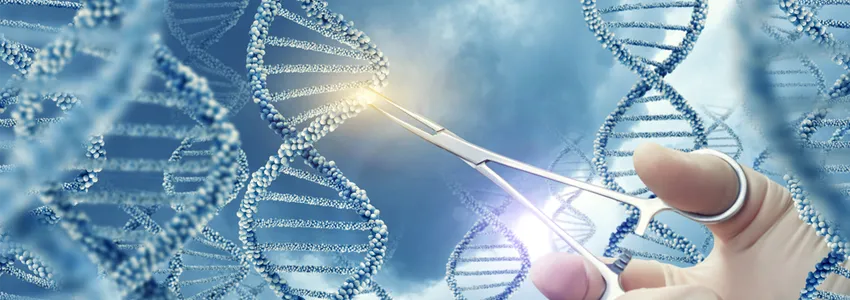
Photo by Natali Mis, Shutterstock.
Stanford Medicine News Center - August 3rd, 2017 - by Jennie Dusheck
A team of genetics experts has issued a policy statement recommending that research on editing human genes in eggs, sperm and early embryos continue, provided the work does not result in a human pregnancy.
Kelly Ormond, MS, professor of genetics at the Stanford School of Medicine, is one of three lead authors of the statement, which provides a framework for regulating the editing of human germ cells. Germ cells, a tiny subset of all the cells in the body, give rise to eggs and sperm. Edits to the genes of germ cells are passed on to offspring.
The statement, published today in the American Journal of Human Genetics, was jointly prepared by the American Society for Human Genetics and four other human genetics organizations, including the National Society of Genetic Counselors, and endorsed by another six, including societies in the United Kingdom, Canada, Australia, Africa and Asia.
Germline gene editing raises a host of technical and ethical questions that, for now, remain largely unanswered. The ASHG policy statement proposes that federal funding for germline genome editing research not be prohibited; that germline editing not be done in any human embryo that would develop inside a woman; and that future clinical germline genome editing in humans not proceed without a compelling medical rationale, evidence supporting clinical use, ethical justification, and a process incorporating input from the public, patients and their families, and other stakeholders.
Ormond recently discussed the issues that prompted the statement’s creation with writer Jennie Dusheck.
Q: Why did you think it was important to issue a statement now?
Ormond: Much of the interest arose a couple of years ago when a group of researchers in China did a proof-of-principle study demonstrating that they could edit the genes of human embryos.
The embryos weren’t viable [meaning they could not lead to a baby], but I think that paper worried people. Gene editing in human germ cells is not technically easy, and it’s not likely to be a top choice for correcting genetic mutations. Still, it worried us that somebody was starting to do it.
We’ve been able to alter genes for many years now, but the new techniques, such as CRISPR/Cas9, that have come out in the past five years have made it a lot easier, and things are moving fast. It’s now quite realistic to do human germline gene editing, and some people have been calling for a moratorium on such work.
Our organization, the American Society of Human Genetics, decided that it would be important to investigate the ethical issues and put out a statement regarding germline genome editing, and what we thought should happen in the near term moving forward.
As we got into the process, we realized that this had global impact because much of the work was happening outside of the United States. And we realized that if someone, anywhere in the world, were moving forward on germline genome editing, that it was going to influence things more broadly. So we reached out to many other countries and organizations to see if we could get global buy-in to the ideas we were thinking about.
Q: Are there regulations now in place that prevent researchers from editing human embryos that could result in a pregnancy and birth?
Ormond: Regulations vary from country to country, so research that is illegal in one country could be legal in another. That’s part of the challenge and why we thought it was so important to have multiple countries involved in this statement.
Also, since 1995 the United States has had regulations against federal funding for research that creates or destroys human embryos. We worry that restricting federal funding on things like germline editing will drive the research underground so there’s less regulation and less transparency. We felt it was really important to say that we support federal funding for this kind of research.
Q: Is germline editing in humans useful and valuable?
Ormond: Germline editing doesn’t have many immediate uses. A lot of people argue that if you’re trying to prevent genetic disease (as opposed to treating it), there are many other ways to do that. We have options like prenatal testing or IVF and pre-implantation genetic testing and then selecting only those embryos that aren’t affected. For the vast majority of situations, those are feasible options for parents concerned about a genetic disease.
The number of situations where you couldn’t use pre-implantation genetic diagnosis to avoid having an affected child are so few and far between. For example, if a parent was what we call a homozygote for a dominant condition such as BRCA1 or Huntington’s disease, or if both members of the couple were affected with the same recessive condition, like cystic fibrosis or sickle cell anemia, it wouldn’t be possible to have a biologically related child that didn’t carry that gene, not unless germline editing were used.
Q: What makes germline editing controversial?
Ormond: There are families out there who see germline editing as a solution to some genetic conditions. For example, during a National Academy of Sciences meeting in December of 2015, a parent stood up and said, “I have a child who has a genetic condition. Please let this move forward; this is something that could help.”
But I also work in disability studies, as it relates to genetic testing, and there are many individuals who feel strongly that genetic testing or changing genes in any way makes a negative statement about them and their worth. So this topic really edges into concerns about eugenics and about what can happen once we have the ability to change our genes.
Germline gene editing impacts not just the individual whose genes are edited, but their future offspring and future generations. We need to listen to all of those voices and try to set a path that takes all of them into account.
That’s a huge debate right now. A lot of people say, “Let’s not mess around with the germline. Let’s only edit genes after a person is born with a medical condition.” Treating an existing medical condition is different from changing someone’s genes from the start, in the germline, when you don’t know what else you’re going to influence.
Q: There was a paper recently about gene editing that caused mutations in excessive numbers of nontargeted genes, so called “off-target effects.” Did that result surprise you or change anything about what you were thinking?
Ormond: I think part of the problem is that this research is moving very fast. One of our biggest challenges was that you can’t do a good ethical assessment of the risks and benefits of a treatment or technology if you don’t know what those risks are, and they remain unclear.
We keep learning about potential risks, including off-target mutations and other unintended consequences. Before anyone ever tries to do germline gene editing in humans, it is very important that we do animal studies where the animals are followed through multiple generations, so that we can see what happens in the long term. There’s just a lot that we don’t know.
There are so many unknowns that we don’t even know what guidelines to set. For example, what’s an appropriate new mutation level in some of these technologies? What is the risk we’re willing to take as we move forward into human studies? And I think those guidelines need to be set as we move forward into clinical trials, both in somatic cells [cells of the body, such as skin cells, neurons, blood cells] and in germline cells.
It’s really hard because, of course, we’re talking about, for the most part, bad diseases that significantly impact quality of life. So if you’re talking about a really serious disease, maybe you’re willing to take more risk there, and these new mutations aren’t likely to be as bad as the genetic condition you already have. But we don’t know, right?
We haven’t had any public dialogue about any of this, and that’s what we need to have. We need to find a way to educate the public and scientists about all of these issues so people can have informed discussions and really come together as this moves forward, so that were not in that reactive place when it potentially becomes a real choice.
And that goes back to your first question, which is why did we feel like we needed to have a statement now? We wanted to get those conversations going.

